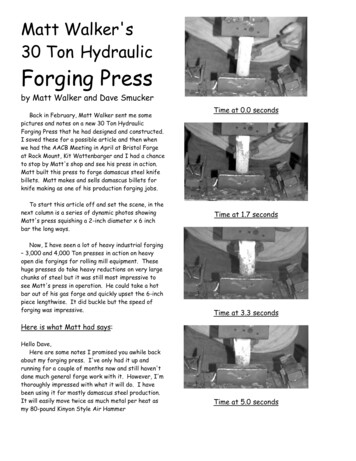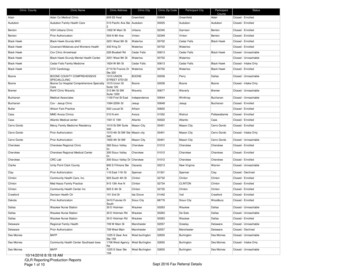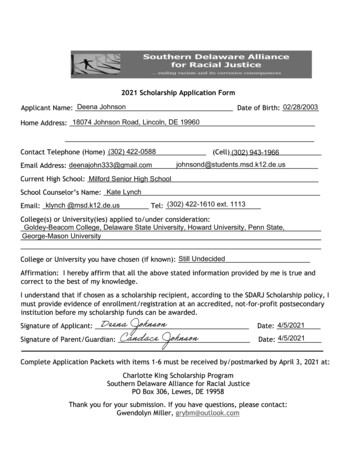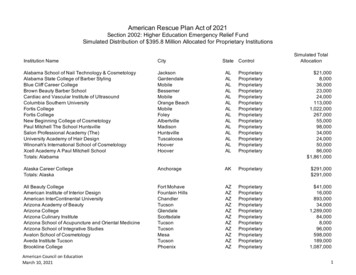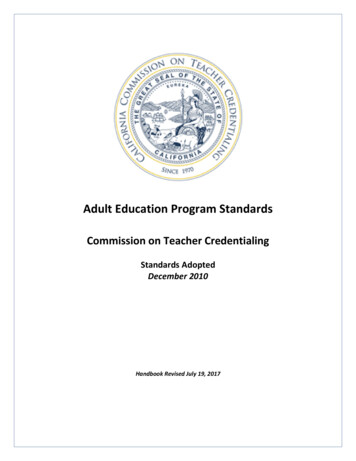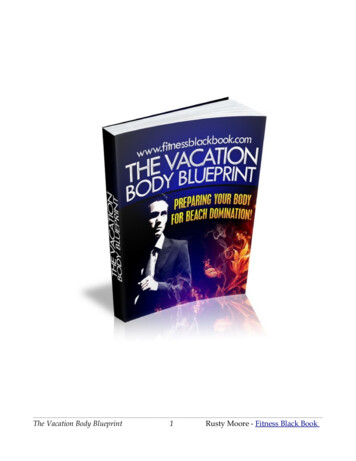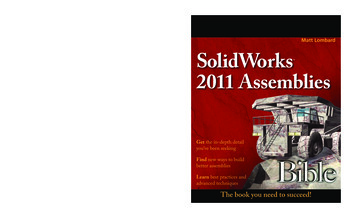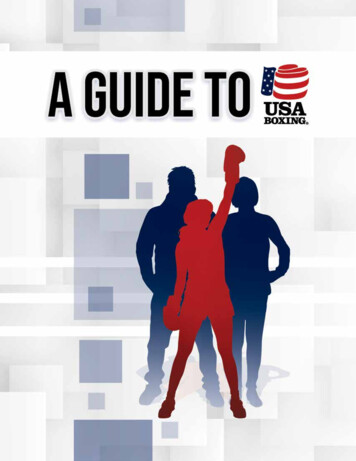
Transcription
01A GUIDE TO USA BOXING
TABLE OF CONTENTSA GUIDE TOQuote from CEO and HP Director1About2Terminology and Definitions3Why an American Development Model?4How safe is Olympic-style Boxing?5SafeSport6Heads up Coaches: Concussion Fact Sheet 7-95 Ways to Prevent Overuse Injury10Sparring – Safety Guidelines11USA Boxing Injury Data12-135 Ways to Talk About the Sport Experience 1402Boxing Parents. What to expect?15Making a Difference/Budgeting16Nutrition17Matchday18Boxer Event Flow19What it means to represent Team USA?20How do I qualify for Team USA?21Mobile Coach App22Code of Conduct23References24A GUIDE TO USA BOXING
USA Boxing is pleased to offer the Guide to USA Boxing, whichhas been collaborative effort between USA Boxing NationalOffice, Local Boxing Committee (LBC) Leaders, Referee and JudgesCommittee, Coaches Committee, the United States Olympic andParalympic Committee and USA Boxing’s High PerformanceDepartment.This comprehensive guide has been the work of USA Boxing members and staff who were ableto put together a document that is beneficial to everyone; first year boxers and parents whilealso expanding and challenging the knowledge of veteran coaches, officials and boxers.The sport of Olympic style boxing is constantly evolvingand by providing safe training and competitive competitionwe can “ endeavor to teach all participants the character,confidence and focus they need to become resilient anddiverse champions, both in and or the ring” and this guideis part of the boxing journey. USA Boxing looks forward toserving you know for many years to come.In your cornerMike McAteeExecutive DirectorMatt Johnson“USA Boxing is excited to provide this guide as a resourceto help new members navigate our organization. Thisguide will provide useful information to boxers andcoaches, along with their families, to better understandour sport and how USA Boxing operates.”1A GUIDE TO USA BOXING
ABOUT USA BOXINGOUR MISSIONTo promote and grow Olympic-style amateur boxing in the United States and toinspire the tireless pursuit of Olympic gold and enable athletes and coaches toachieve sustained competitive excellence. Additionally, USA Boxing endeavors toteach all participants the character, confidence and focus they need to becomeresilient and diverse champions, both in and out of the ring. USA Boxing is oneteam, one nation, going for gold!HistoryThe United States recognized amateur boxing asan organized sport in 1888, with the first Olympicteam making their appearance in 1904. Sincethen, Team USA leads the global medal race inboxing winning a total of 113 medals, 51 of themgold. With over 22,000 registered boxers, amateurboxing has provided competitive opportunities forthousands of young men and women.Olympic-style boxing’s popularity has a largeglobal appeal, developing its own identity andrules, independent ofprofessional boxing.Originally knownas the UnitedStates AmateurBoxing Federation,USA Boxing is theNational GoverningBody which overseesamateur boxing inthe United States.2HerstoryIn 1993 women were granted the right to participate inamateur boxing, with many international organizationsfollowing suit a year later.Nearly a decade later, women celebrated anothermilestone as 2012 marked the year women wereallowed to compete in the Olympic Games. Tocommemorate the occasion, middleweight ClaressaShields earned Team USA its first gold medal inwomen’s boxing. She repeated that feat in 2016,making her not only the first woman to win two goldmedals, but the first American, male or female, to wintwo gold medals in the sport of boxing.There are presently five (5) weight class opportunitiesfor women competing at the Olympic Games toaccompany the eight (8) weight classes for men.A GUIDE TO USA BOXING
TERMS & DEFINITIONSAIBA Amateur boxing’s international governingbody, formerly known as AssociationInternationale de Boxe Amateur.Bag gloves gloves used to hit training equipment,wears on their hands to work skills and strategieswith the boxer.not intended for sparring.NGB National Governing Body. Every sport underBout a single word synonym for a boxing match.Officials judges, referees, timekeepers, gloveBob and weave moving the head in an evasivefashion, up and down, and side to side.Card a synonym for a boxing event with multipleboxing bouts.Clinch when both boxers mutually hold eachthe US Olympic & Paralympic Committee isrecognized as an NGB.table supervisors, etc.Orthodox a right-handed boxer.Parry a defensive move where a boxer redirects aother. “Holding” is a foul when one boxer isrestricting the other boxer.punch.Feint a synonym for “fake,” most commonly usedRound a segment of the boxing match, similarCombination series of punches.with a foot, hand, shoulder, or eyes.Field of Play (FOP) the competition ring areawhere the athletes box, and the judges judge.Hand-wraps fabric used to protect the hands.Headgear a soft helmet used to protect the headduring training and competitions. Competitionheadgear must have a tag showing approval to beused in USA Boxing sanctioned boxing matches.See Rule 37 of the USA Boxing National Rule Book.KO a knockout happens when a boxer has gonedown from the result of a punch and cannotresume boxing by the count of ten (10). Forcomplete rules regarding KO’s, please see the USABoxing National Rule Book.LBC is a Local Boxing Committee, representing3Mitts (pads) padded targets that the coacha district for competitions and competitionmanagement. Each LBC is governed by a Boardof Directors. Boxers, coaches, and officials areregistered through their LBC, as well as sanctionapproval for boxing cards.Ringmanship (Ring Generalship) used todescribe the ability and skills to control thecompetition area.to a period or quarter in other sports. Thereare always three (3) rounds, with 60 secondsseparating each round, but depending upon theage and experience of the boxers, the duration ofeach round will vary.Sanction a boxing event is registered with USABoxing; every amateur boxing event where thereare spectators and a fee need to be “sanctioned”with USA Boxing.Second Once a coach enters the Field of Play(FOP), they are referred to as a “second,” with theboxer being the “principal.”Southpaw a left-handed boxer.Spar practice boxing, usually with bigger traininggloves, and headgear.Stick and move using jabs and footwork to scoreand evade.Training (sparring) gloves gloves that are madefor sparring, to protect the boxer’s hands and thespar mate’s head.A GUIDE TO USA BOXINGA GUIDE TO USA BOXING
“FUN!” IS THEMAIN REASON 9 OUTOF 10 CHILDREN SAYTHEY PARTICIPATEIN SPORTS.70% OF KIDS DROP OUTOF SPORT BY AGE 13DUE TO INJURY, BURNOUT,AND PRESSURE TOSPECIALIZE TOO EARLY.WHY AN AMERICANDEVELOPMENT MODEL?How can boxing coaches, parents and teammateshave a positive impact on the above numbers, inour gyms and Local Boxing Committees (LBCs)?How can we make a difference by keeping our kidsactive, healthy, and involved in sports like boxing?To combat these issues USA Boxing has partnered withthe United States Olympic & Paralympic Committee(USOPC) to adapt the American DevelopmentModel (ADM) to the sport of boxing. The ADM isa set of guidelines and recommendations to bestintroduce boxing as an athletic activity and to retainparticipation through both recreation and competition.The boxing ADM is comprised of five stages designedto create a healthy sport experience and pathwayto support an athlete’s advancement based on theirphysical, mental, and emotional level, and potentialfor growth. The boxing ADM can be used to referencewhat key concepts athletes should be focused on andto encourage athletes as they develop and grow intheir athletic experiences. The pathway stages areguides to explain how athletes navigate developmentand competitive expectations as they journey throughthe sport of Olympic-style boxing.OBESITY IN AMERICAN TEENAGERSHAS RISEN TO 20.6% (2015-2016)FROM 5% (1976-1980)AS REPORTED BY THE CDC.FOR MORE INFORMATION about USA Boxing’s Guideto the American Development Model CLICK HERE.4A GUIDE TO USA BOXING
HOW SAFEIS OLYMPICSTYLE BOXING?Safety is a top priority for USA Boxing.USAB boxing provides a safe haven forthousands of youths in this country, whilehelping them to gain self-recognitionand a positive self-image. It is one of thesafest, most highly regulated sports of allamateur athletics. Amateur boxing is notabout knocking your opponent out and infact, almost all boxing matches are won bypoints.As an Olympic sport, there are countlessprecautions and rules to protect boxers.There are inevitable risks involved with anysport or activity and this is why amateurboxing’s governing body, USA Boxing,places such an inordinate amount ofimportance on following strict guidelinesfor safety in training and competition. Awell-run, highly supervised, structuredboxing program is the best athleticendeavor any boy or girl could pursue.Regardless of gender, age, race, size, socialor financial status, boxing offers a levelplaying field and an accepting environment.During Competition Prior to competition a boxer must register with USABand have a pre-bout physical evaluation by a USAB doctor.There will also be a post-bout clearance from the ringsidephysician before the boxer is allowed to leave the Field ofPlay (FOP). USAB doctors utilize a Medical Handbook to use as areference guide and educational tool specific to Olympic styleboxing. The referee is registered, educated, and certified by USAB,and has the duty and responsibility to govern the match,keeping order byv enforcing the rules. Securing the safety andwellbeing of both boxers is an official’s primary task. Olympic style boxers are judged on clean points scored on theopponent’s target area, competitive attitude, sportsmanship,and controlling the ring. Boxers are matched in competition by four (4) criteria: age,weight, gender, and experience. Competition gear (groin protector, mouthpiece, headgear,gloves) must meet USAB standards.In the Gym As part of USAB, all registered clubs, coaches and athletes have insurance. All coaches that oversee sparring (practice matches and drills) and competitions arerequired to be registered with USAB and must pass SafeSport every year and coachingeducation certification course within the past two (2) years. All athletes involved are required to be registered before they can participate incontact drills, sparring and/or competition.5 Safety equipment (proper shoes, groin protector for males, headgear, mouthpiece,training gloves) must be worn during any contact drills and sparring.A GUIDE TO USA BOXING
The safety of all participants is the top priorityof USA Boxing, both in and out of the ring. Toensure the safety of all participants is a top priorityand USA Boxing works with leading organizations,including the United States Olympic & ParalympicCommittee (USOPC) and the U.S. Center forSafeSport to follow protocols and best practices atall times.SafeSport includes policies that prohibitsexual, physical, and emotional abuse, bullying,harassment, and hazing. These policies alsospecifically address areas such as one-on-oneinteractions, locker rooms, online and socialmedia, and team travel. SafeSport also providesa streamlined and neutral process for reportingalleged inappropriate behavior.TRAINING REQUIREMENTS: All non-athlete USABoxing members (coaches, officials, and physicians),USA Boxing employees, and Board of Directormembers are required to complete SafeSporttraining, as well as pass a background screening.6Parents can take the free “Parent’s Guide toMisconduct in Sport” course on the U.S. Centerfor SafeSport’s website, where it also offers ageappropriate courses for minor athletes. These freeonline trainings are designed as an introductionfor minor athletes and their parents/caregivers tounderstand the importance of positive, welcomingenvironments, and where to report abuse, should itoccur.OBSERVABLE and INTERRUPTIBLE: Rememberthat all one-on-one interactions between a minorathlete and Applicable Adult (who is not the minor’slegal guardian) at a facility partially or fully underUSA Boxing’s jurisdiction are permitted only if theyoccur at an observable and interruptible distanceby another adult. Meetings should only occur withanother adult present, except under emergencysituations.MANDATORY REPORTING: All non-athlete USABoxing members, USA Boxing employees, and Boardof Director members are considered mandatoryreporters and are required by law to report actualor suspected sexual misconduct or child abuseto the U.S. Center for SafeSport and to local lawenforcement.Anyone who violates any of the SafeSport policies may be denied eligibility within any USA Boxingprogram and is subject to appropriate disciplinary action including but not limited to suspension,permanent suspension, and/or referral to law enforcement authorities. If you become aware of any issuesthat should be reported, or would like MORE INFORMATION, please visit the U.S. Center for SafeSportwebsite HERE.A GUIDE TO USA BOXING
CONCUSSION FACT SHEETOne of the main jobs of a youth sports coach iskeeping athletes safe. This sheet has informationto help coaches protect boxers from concussion or other seriousbrain injury, learn how to spot a concussion, and know whatto do if a concussion occurs. It is important for parents tounderstand this information.WHAT IS A CONCUSSION?A concussion is a type of traumatic brain injury—or TBI—caused by a bump, blow, or jolt to the head or by a hit to thebody that causes the head and brain to move quickly back andforth. This fast movement can cause the brain to bounce aroundor twist in the skull, creating chemical changes in the brain andsometimes stretching and damaging the brain cells.HOW CAN COACHES HELP KEEP BOXERS SAFE?Sports are a great way for children and teens to stay healthyand can help them do well in school. A youth sports coach’sactions creates the culture for safety and can help lower aboxer’s chance of getting a concussion or other serious injury.Aggressive and/or unsportsmanlike behavior among boxers canincrease their chances of getting a concussion or other seriousinjury. Here are some ways coaches c an help keep boxers safe:7Talk with athletes about the importanceof reporting a concussion: Talk with boxers about any concerns they might haveabout reporting their concussion symptoms. Make sure totell them that safety comes first, and you expect them to tellcoaches and their parent(s) if they think they have a concussion.Create a culture of safety at competition and training: Teach boxers ways to lower the chances of getting aconcussion. Enforce the rules of the sport for fair play, safety, andsportsmanship. Ensure boxers avoid unsafe actions such as:- Using their head or headgear to contact another boxer.- Making illegal blows, or colliding with an unprotectedopponent; and/or- Trying to injure or put another boxer at risk for injury.- Tell boxers that good sportsmanship is expected, both in andout of the ring.Keep up to date on concussioninformation: Review your state and USA Boxing’sconcussion guidelines and protocols. Take a training course on concussion. CDCoffers concussion training at no cost:www.cdc.gov/HEADSUP Download CDC’s HEADS UP app or a listof concussion signs and symptoms that youcan keep on hand.Check out the equipment &sports facilities: Make sure all boxers wear headgearin training and competition that fitswell and is in good condition. There isno “concussion-proof” headgear, so it isimportant to enforce safety rules thatprotect boxers from hits to the head andwhen headgear falls off during a play. Work with event administrator toremove tripping hazards and ensure thatequipment has padding that is in goodcondition.Keep emergency contactinformation handy: Bring emergency contact informationfor parents and health care providers toeach competition and practice in case aboxer needs to be taken to an emergencydepartment right away for a concussion orother serious injury. If first responders are called to care foran injured boxer, provide them with detailsabout how the injury happened and howthe boxer was acting after the injury.A GUIDE TO USA BOXING
HOW CAN COACHES AND PARENTSSPOT A POSSIBLE CONCUSSION?Boxers who show or report one or more of the signsand symptoms listed below—or simply say they just“don’t feel right” after a bump, blow, or jolt to the heador body—may have a concussion or other serious braininjury.Signs observed by coaches or parents: Appears dazed or stunned. Forgets an instruction, is confused about anassignment or position, or is unsure of the bout,round, or opponent. Moves clumsily. Answers questions slowly. Loses consciousness (even briefly). Shows mood, behavior, or personality changes. Cannot recall events prior to or after a hit or fall.Symptoms reported by boxers: Headache or “pressure” in head. Nausea or vomiting. Balance problems or dizziness, or double or blurryvision. Bothered by light or noise. Feeling sluggish, hazy, foggy, or groggy. Confusion, or concentration or memory problems. Just not “feeling right”, or “feeling down”.NOTE: Concussion signs and symptoms often showup soon after the injury, but it can be hard to tell howserious the concussion is at first. Some symptoms maynot be noticed or may not show up for hours or days.WHAT ARE SOME MORE SERIOUSDANGER SIGNS TO LOOK FOR?In rare cases, a dangerous collection of blood(hematoma) may form on the brain after a bump, blow,or jolt to the head or body and can squeeze the brainagainst the skull. Call 9-1-1 or ensure a boxer is taken tothe emergency department right away if, after a bump,blow, or jolt to the head or body, he or she has one ormore of these danger signs: One pupil larger than the other. Drowsiness or inability to wake up. A headache that gets worse and does not go away.8 Slurred speech, weakness, numbness, or decreasedcoordination. Repeated vomiting or nausea, convulsions, orseizures (shaking or twitching). Unusual behavior, increased confusion, restlessness,or agitation. Loss of consciousness (passed out/knocked out).Even a brief loss of consciousness should be takenseriously.CONCUSSIONS AFFECT EACHBOXER DIFFERENTLYWhile most boxers with a concussion feel betterwithin a couple of weeks, some will have symptomsfor months or longer. Talk with a boxer’s parent if younotice their concussion symptoms come back afterthey return to training or competition.WHAT SHOULD A COACH DO IF THEYTHINK A BOXER HAS A POSSIBLECONCUSSION?As a coach, if you think a boxer may have a concussion,you should:Remove the boxer from play.When in doubt, sit them out!Keep a boxer with a possible concussion out ofcompetition on the same day on the injury anduntil cleared by a health care provider.Do not try to judge the severity of the injury yourself.Only a health care provider should assess an athlete fora possible concussion. After you remove a boxer witha possible concussion from practice or competition,the decision about return to practice or competitionis a medical decision that should be made by a healthcare provider. As a coach, recording the followinginformation can help a health care provider in assessingthe boxer after the injury: Cause of the injury and force of the hit or blow to thehead or body. Any loss of consciousness (passed out/knocked out)and if so, for how long. Any memory loss right after the injury. Any seizures right after the injury. Number of previous concussions (if any).A GUIDE TO USA BOXING
Inform the boxer's parent(s) aboutthe possible concussion.Let them know about the possible concussion and givethem the HEADS-UP fact sheet for parents. This factsheet can help parents watch the boxer for concussionsigns or symptoms that may show up or get worse oncethe boxer is at home or returns to school.Ask for written instructions from the boxer'shealth care provider on return to training.These instructions should include information aboutwhen they can return to play and what steps youshould take to help them safely return to training andcompetition.WHY SHOULD A COACH REMOVE A BOXERWITH A POSSIBLE CONCUSSION FROMPLAY?The brain needs time to heal after a concussion. Anathlete who continues to train or compete with aconcussion has a greater chance of getting anotherconcussion. A repeat concussion that occurs while thebrain is still healing from the first injury can be veryserious and can affect an athlete for a lifetime. It caneven be fatal.SOME BOXERS MAY NOT REPORT ACONCUSSION BECAUSE THEY DON’TTHINK A CONCUSSION IS SERIOUSThey may also worry about: Losing the bout or their position on the team. Jeopardizing their future sports career. Looking weak. Letting their teammates or the team down. What their coach or teammates might think of them.WHAT STEPS CAN COACHES TAKE TOHELP A BOXER RETURN TO TRAININGAND COMPETITION?A boxer’s return to school and sports should be agradual process that is approved and carefully managedand monitored by a health care provider. If available,be sure to also work closely with your team’s certifiedathletic trainer or primary healthcare provider.Learn more at: cdc.gov/HEADSUP9Below are five gradual steps that should be followedto help return a boxer safely to play. Remember,this is a gradual process. These steps should not becompleted in one day, but instead over days, weeks, ormonths.BASELINE: Boxer is back to their regular schoolactivities, is no longer experiencing symptoms from theinjury when doing normal activities and has a green lightfrom their health care provider to begin the return to playprocess.A boxer should only move to the next step if they donot have any new symptoms at the current step.STEP 1: Begin with light aerobic exercise only toincrease a boxer’s heart rate. This means about 5 to 10minutes on an exercise bike, walking, or light jogging. Noweightlifting at this point.STEP 2: Continue with activities to increase a boxer’sheart rate with body or head movement. This includesmoderate jogging, brief running, moderate-intensitystationary biking, moderate-intensity weightlifting (lesstime and/or less weight than a typical routine).STEP 3: Add heavy non-contact physical activity, suchas sprinting/ running, high-intensity stationary biking,regular weightlifting routine, non-contact sport-specificdrills (in 3 planes of movement).STEP 4: A boxer may return to training and full contactin controlled practice.STEP 5: A boxer may return to competition.REMEMBER: It is important for coaches and theboxer’s parent(s) to watch for concussion symptomsafter each day’s return to play progression activity. Ifan athlete’s concussion symptoms come back, or he orshe gets new symptoms when becoming more active atany step, this is a sign that the athlete is pushing him- orherself too hard. The boxer should stop these activities,and the boxer’s health care provider should be contacted.After the okay from the boxer’s health care provider, theboxer can begin at the previous step.A GUIDE TO USA BOXING
10A GUIDE TO USA BOXING
SPARRING &SAFETY GUIDELINESSparring is an important part of preparing a boxer for competition.A coach must properly prepare and supervise a sparring session,with the priority being the boxers’ safety and then their development.To prevent discouragement, it is critical to have goals and guidelines inplace to ensure that sparring sessions are both safe and productive forall boxers involved.SAFETY RULES & SAFE ENVIRONMENT1. Sparring must always be supervised by a USA Boxingcertified coach (registered, SafeSport, background check).2. Boxers should wear mouthpieces, protective cup,headgear, and size appropriate (training) gloves (by age,weight, experience), while sparring.3. Boxers should always spar in a controlled manner.4. Sparring should be stopped and evaluated at any time asparring session gets one-sided.5.Safety is always the number one priority during sparringand competition.HEADS UP - Concussion Awareness & TrainingOne of the main jobs of a coach and parent is keepingathletes safe. Your actions create the culture for safety andcan help lower a boxer’s chance of a concussion or seriousinjury. Here are a few tips to help keep your boxer safe:Create a culture of safety at competition and training.Talk with boxers about the importance of reporting aconcussion.Know the signs and symptoms of a concussion.Remove the boxer from play (when in doubt, sit themout!)Stay up to date on concussion information.Check the condition of equipment and sports facilities.Keep emergency contact information handy.11FOR MORE INFORMATION & FREE TRAININGfrom the CDC, visit: www.cdc.gov/HEADSUPA GUIDE TO USA BOXING
USA BOXINGINJURY DATAINJURY PROBABILITY % - BY SPORT*Boxer ages ranged from 8-82.All other participant ages ranged from 10-18.Sources: USA Boxing match data, Journal of the American Academy of Pedriatrics12A GUIDE TO USA BOXING
Facial Injury Data - Combat Sports, 2008 - 2013n 1143Injury Type (%)INJURIES - EVERY 10 PARTICIPANTS - BY SPORTSources: American Academy of Pediatrics, USA Boxing Inc. match data13A GUIDE TO USA BOXING
14A GUIDE TO USA BOXING
BOXING PARENTSWhat to expect?ENJOYING THE EXPERIENCERemember, above all, boxing is a sport meantto be fun at all levels. The boxing community is a greatopportunity to meet lifelong friends and create lasting memories forall involved. Keep boxing in perspective and help your boxer do thesame because results are often not as important as gaining experienceand making memories.Ideas to make the experience great! Create a scrapbook or social media page to include photos, newsclippings, and tournament information to share with family andfriends. Turn tournament road trips into a family vacation; explore thesites along the way and experience the local culture. Coordinate public service opportunities for the boxing gym/club,such as a food or toy drive.5 Signs Your Child isHaving Fun in Sports1. They choose to practice outside offormal training sessions.2. They are eager to get to practice/competitions and like to talk aboutthem.3. They are trying to get friends tojoin the sport.4. They like to hang out with theteam after practice/competition.5. They like to watch high-levelcompetitions.Ideas on how to get involved! You do not need to be a coach to get involved. Every local gym/club needsvolunteers and can alsostrengthen your association. Volunteer at local boxingshows. There are so manyjobs to help make a show runsmoothly. Organize fundraisers. Help with administrativework for coaches/gym (e.g.,passbook maintenance). Seek support/sponsorshipsfrom local business, citycouncil, and communityleaders.Just express interest to your LBC that you want to help!Click HERE to find more LBC information:15A GUIDE TO USA BOXING
PARENTSCan Make a Difference in the Experience!Parents have the greatest influence on the experience of yourboxer. Embrace that opportunity and encourage your boxer’sdevelopment!Remember:Let kids be kids. Fun should be paramount.Be supportive.Be disciplined. Manage your emotions and set a good example thatteaches your boxer to do the same.Be positive, and when adversity comes, be constructive notdestructive. If you must be critical, do not get personal. Direct yourcomment at the action, not the person.Be proactive. Get involved as a volunteer or coach in your club.Communicate with coaches and administrators to help avoidfrustration and conflict.Your boxer’s coach is likely a volunteer and donating theirtime. While criticism might be appropriate, it should be doneconstructively and through appropriate channels.Be respectful, especially in situations of disagreement or conflict.Do not bully or harass. Speak out if you see bullying or harassingbehavior from others.Focus on the process, not the outcome, and teach your boxer to dothe same.Kids learn best by doing.Praise your boxer’s effort more often than their performance.Studies show it helps them better develop the confidence to meetnew challenges and overcome obstacles.Keep boxing in perspective. Maintain a healthy balance of boxingand non-boxing activities. Encourage your boxer to be wellrounded.Enjoy the boxing experience with your child. Life moves fast andtime passes quickly.BASIC EQUIPMENTHand wraps Mouthpiece Jump rope Bag glovesTraining/sparring gloves HeadgearProtective cup/breastplate Boxing/wrestling shoes16 BUDGETING TIPSAll sports and extracurricularactivities involve some financialinvestment, but with someplanning and discernment, youcan keep your budget in check! ASK other parents and your gymleaders for guidance. They are awealth of knowledge, experience,and connections.REMEMBER you do not needto buy top of the line equipment.There are many online andlocal outlets offering affordableequipment (including equipmentsold at usaboxing.org).BE AWARE what is included inyour membership fees and howmoney is allocated by your LBC.AVOID spending money onimpulse at concession standsand during road trips. Packlunches. Stay in hotels thatoffer complimentary breakfast.Reduce travel by participating inlocal and regional shows to gainexperience. A GUIDE TO USA BOXING
NUTRITIONAthlete’s PlateTraining volume and intensity vary fromday to day and week to week along yourtraining/competition plan. Eating meals andfueling a workout or race should also be cycledaccording to how hard or easy it is. Consult withyour sport dietitian to put the Athlete’s Plateinto practice! The Athlete’s Plates are tools to betteradjust eating with the physical demandsof sports!EASY An easy day may contain an easyworkout or tapering without the need to load upfor competition with energy and nutrients. Easyday meals may also apply to athletes trying tolose weight and athletes in sports requiring lessenergy (calories) due to the nature of their sport.MODERATE A moderateday may be one where one trains twice butfocuses on technical skills in one workout andon endurance or strength in the other. Themoderate day should be the baseline from
boxing has provided competitive opportunities for thousands of young men and women. Olympic-style boxing’s popularity has a large global appeal, developing its own identity and rules, independent of professional boxing. Originally known as the United States Amateur Boxing Federation, USA Boxi
